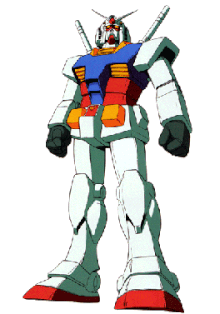Mecha
In science fiction, mecha (Japanese: メカ, Hepburn: meka) or mechs are giant robots or machines, typically depicted as piloted, humanoid walking vehicles.For example, in Gundam the fictional Minovsky particle inhibits the use of radar, making long-range ballistic strikes impractical, thus favouring relatively close-range warfare of Mobile Suits.[2] However, some stories, such as the manga/anime franchise Patlabor and the American wargame BattleTech universe, also encompass mecha used for civilian purposes, such as heavy construction work, police functions, or firefighting.Mecha have been used in fantasy settings, for example in the anime series Aura Battler Dunbine, The Vision of Escaflowne, Panzer World Galient, and Maze.Ōgon Bat, a kamishibai that debuted in 1931 (later adapted into an anime in 1967), featured the first piloted humanoid giant robot, Dai Ningen Tanku (大人間タンク),[7] but as an enemy rather than a protagonist.[8] The first humanoid giant robot piloted by the protagonist appeared in the manga Atomic Power Android (原子力人造人間, Genshi Ryoku Jinzō Ningen) in 1948.The first anime featuring a giant mecha being piloted by the protagonist from within a cockpit was the Super Robot show Mazinger Z, written by Go Nagai and introduced in 1972.Ken Ishikawa and Go Nagai, later, introduced the concept of 'combination' (gattai (合体)), where several units slot together to form a super robot, with Getter Robo (1974 debut).[11] An early use of mech-like machines outside Japan is found in "The Invisible Empire", a Federal Men's story arc by Jerry Siegel and Joe Shuster (serialized 1936 in New Comics #8–10).[12] Other examples include the Mexican comic Invictus by Leonel Guillermo Prieto and Victaleno León; the Brazilian comic Audaz, o demolidor, by Álvaro "Aruom" Moura and Messias de Mello (1938–1949), inspired by Invictus, created for the supplement A Gazetinha from the newspaper A Gazeta;[13] Kimball Kinnison's battle suit in E. E. "Doc" Smith's Lensman novel Galactic Patrol (1950);[14] the French animated film The King and the Mockingbird (first released 1952),[15] and Robert Heinlein's waldo in his 1942 short story, "Waldo" and the Mobile Infantry battle suits in Heinlein's Starship Troopers (1958).Some of them may not be considerably taller than a tank (Armored Trooper Votoms,Yatterman, Megazone 23, Code Geass), some may be a few stories tall (Gundam, Escaflowne, Bismark, Gurren Lagann), others can be titan sized as tall as a skyscraper (Space Runaway Ideon, Genesis of Aquarion, Science Ninja Team Gatchaman, Neon Genesis Evangelion), some are big enough to contain an entire city (Macross), some the size of a planet (Diebuster), galaxies (Getter Robo, Tengen Toppa Gurren Lagann), or even as large as universes (Tengen Toppa Gurren Lagann: Lagann-hen, Demonbane, Transformers: Alternity).[22] Some robot mecha are capable of transformation (Macross and Zeta Gundam) or combining to form even bigger ones (Beast King GoLion and Tengen Toppa Gurren Lagann), the latter called 'combination'.




Mecha (disambiguation)Giant Robot (disambiguation)Mech (disambiguation)KuratasSuidobashi Heavy IndustryMaker Fairescience fictionJapaneseHepburnvehiclesSuper RobotReal Robotrobotic platformsotherwisecomputerscockpitpowered armorIron ManIron MongerGundamgladiatorial matchesmilitaryfighter aircraftinfantryPatlaborBattleTechuniversepolicefirefightinghazmat suitsresearch and developmentAura Battler DunbineThe Vision of EscaflownePanzer World Galientevolvefictionalknee jointdigitigradeEdward S. EllisThe Steam Man of the PrairiesJules VerneThe Steam HousetripodH. G. WellsThe War of the WorldslocomotionŌgon BatkamishibaiTank TankuroTetsujin 28-GoAstro BoyMazinger ZGo NagaiGetter RoboJerry SiegelJoe ShusterNew ComicsMessias de Mellobattle suitE. E. "Doc" Smith'sLensmanGalactic PatrolThe King and the MockingbirdRobert HeinleinStarship TroopersShōji KawamoriDiacloneMacrossRobotechTransformersVF-1 ValkyrieOptimus PrimeMecha anime and mangaRX-78-2 GundamMobile Suit GundamArmored Trooper VotomsYattermanMegazone 23Code GeassEscaflowneBismarkGurren LagannskyscraperSpace Runaway IdeonGenesis of AquarionScience Ninja Team GatchamanNeon Genesis EvangelionDiebusterTengen Toppa Gurren LagannDemonbanedie-cast metal toysChogokinShogun Warriorssuper robotssuperheromad geniusteenagersvoice commandneural uplinkThe Super Dimension Fortress MacrossZeta GundamBeast King GoLionKen IshikawaEureka SevenThe Empire Strikes Backoriginal Star Wars trilogyGodzilla franchiseMechagodzillaGodzilla vs. MechagodzillaJapan Self-Defense ForcesSuper MechagodzillaUnited NationsMonsterVerseGodzilla and King KongGhidorahkaijusMecha-King GhidorahGodzillaThe MysteriansGodzilla vs. SpaceGodzillaM.O.G.U.E.R.A.SpaceGodzillaStar WarswalkerRobot JoxAliens